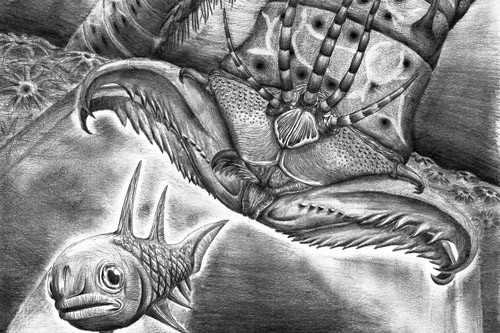By Ana Verayo, | February 23, 2017

An artistic reconstruction showing W. armstrongi attacking a fish in the Devonian sea. (James Ormiston/University of Bristol)
Scientists have discovered a colossal, giant worm that is 400 million years old hidden inside a museum. This ancient worm also possesses terrifying snapping jaws and was hidden from sight in the Royal Ontario Museum in Canada since 1994.
A team from the University of Bristol and Lund University in Sweden has identified this new species and attributed its massive size to giant modern day eunicidan species are known as "Bobbit worms." These worms are frightening predators that use an ambush technique to capture their prey with their powerful jaws.
Like Us on Facebook
Scientists consider this as a unique worm species due to its significantly giant sized jaws that can measure up to one centimeter, which is also the largest for this type of worm species. Most fossilized worm jaws are only a few millimeters in size and can only be seen in microscopic views. However, this ancient 400 million years old worm's jaws can easily be seen by the naked eye.
According to the lead author of the study, Mats Eriksson of Lund University, gigantism found in animals is very provocative and an ecologically important trait, which means that these animals evolved with the advantages of competitive dominance. However, this is also a poorly understood case since gigantism in marine worms is rarely seen in fossilized records. This new species, therefore, presents a case of polychaete gigantism during the Paleozoic era.
According to the co-author of the study, Luke Parry of the University of Bristol's School of Earth Sciences, this discovery also reveals gigantism in jaw bearing polychaetes that were limited to one particular evolutionary group in the eunicida, evolving many times in different species.
Researchers also explain that competitive dominance is often linked to gigantism and this is how modern worms can get this large and develop into fearsome predators. However, this discovery is not directly related to these living worms, suggesting that when there are ideal conditions or a necessity, polychaete worms can develop into gigantic sizes.
This new species has been named as Websteroprion armstrongi after Derek K. Armstrong from the Ontario Geological Survey who first collected the specimen while examining rocks and fossils back in 1994. This massive ancient worm is also named after bass player Alex Webster of death metal band Cannibal Corpse since the authors of the study are fans and musicians.
This new study was published in the journal, Scientific Reports.
-
Use of Coronavirus Pandemic Drones Raises Privacy Concerns: Drones Spread Fear, Local Officials Say

-
Coronavirus Hampers The Delivery Of Lockheed Martin F-35 Stealth Fighters For 2020

-
Instagram Speeds Up Plans to Add Account Memorialization Feature Due to COVID-19 Deaths

-
NASA: Perseverance Plans to Bring 'Mars Rock' to Earth in 2031

-
600 Dead And 3,000 In The Hospital as Iranians Believed Drinking High-Concentrations of Alcohol Can Cure The Coronavirus

-
600 Dead And 3,000 In The Hospital as Iranians Believed Drinking High-Concentrations of Alcohol Can Cure The Coronavirus

-
COVID-19: Doctors, Nurses Use Virtual Reality to Learn New Skills in Treating Coronavirus Patients







